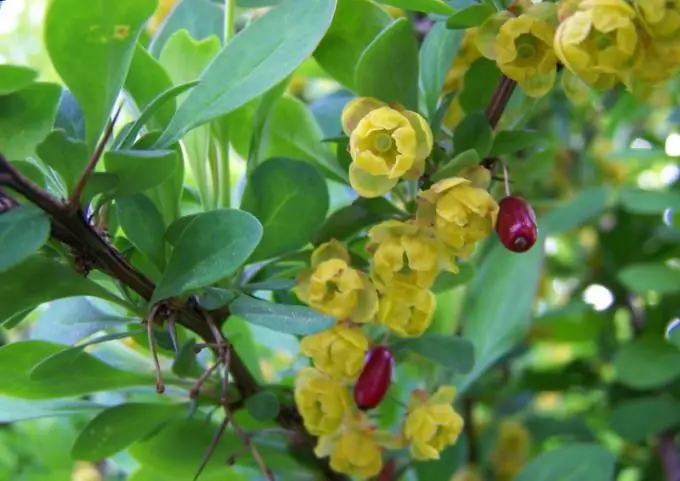- Author Nora Macey [email protected].
- Public 2023-12-16 10:17.
- Last modified 2025-01-23 08:48.
The plant called barberry is widespread in the European part of Russia, mainly in the Crimea and the Caucasus. This undemanding shrub is drought-resistant and frost-resistant.

Instructions
Step 1
In the old days, traditional medicine used fruits, flowers, bark, leaves and roots of barberry to prepare herbal preparations. Currently, only fruits, leaves and roots are used. Barberry flowers are popular with bees, although the smell of these flowers is specific and even unpleasant. Bees collect a large amount of nectar from barberry bushes, and honey from barberry has healing properties, has a yellow color and a specific smell and taste.
Step 2
The barberry fruit is a bright red, oblong, sour berry with a specific flavor. They are eaten fresh, in compotes, jam, pickled. They can be used as a medicine to stimulate appetite, quench thirst. You can use the fruit of barberry as a means to lower body temperature, with fever to relieve the condition. Barberry is used as a means of improving blood circulation and as a choleretic. Collections with the addition of barberry are effective for cholecystitis and cholangitis. Often used in medicine, the fruits of barberry as an anti-inflammatory, hemostatic agent. In the folk medicine of Transbaikalia, barberry is considered a diaphoretic and astringent.
Step 3
In Uzbekistan, barberry is considered a remedy for neurasthenia, for heart disease and as a fixative. In France, barberry is officially recognized as a medicine and is used as a bactericidal, antihypertensive, anti-febrile agent and is used as a stimulant of the digestive system. Barberry preparations are used in England as a hemostatic, especially effective for internal bleeding. Berries are used to treat acute gastrointestinal diseases accompanied by diarrhea and vomiting. Barberry and preparations from it are very popular in Poland, but there they give preference to various decoctions, infusions and tinctures from barberry leaves.
Step 4
In the veterinary industry, tincture and infusion of barberry leaves are most often used. The main pharmacologically active substance in barberry is the alkaloid berberine. It is found in all parts of the plant, except for flowers and ripe berries. Instead, ripe berries contain many organic acids: citric, tartaric, malic. High in ripe berries and the content of pectin and choline-like substances, sugars, vitamins. Previously, barberry was more widespread and grew everywhere, but then it was discovered that this shrub is the host and carrier of fungal rust, a dangerous parasite of all cereals. Since then, in the vicinity of the fields, it has been exterminated and is grown only as an ornamental plant.






